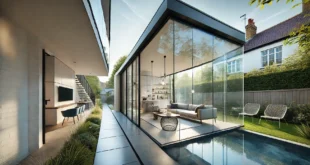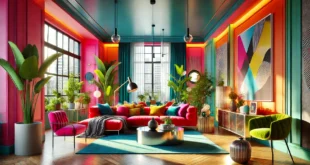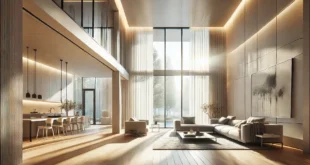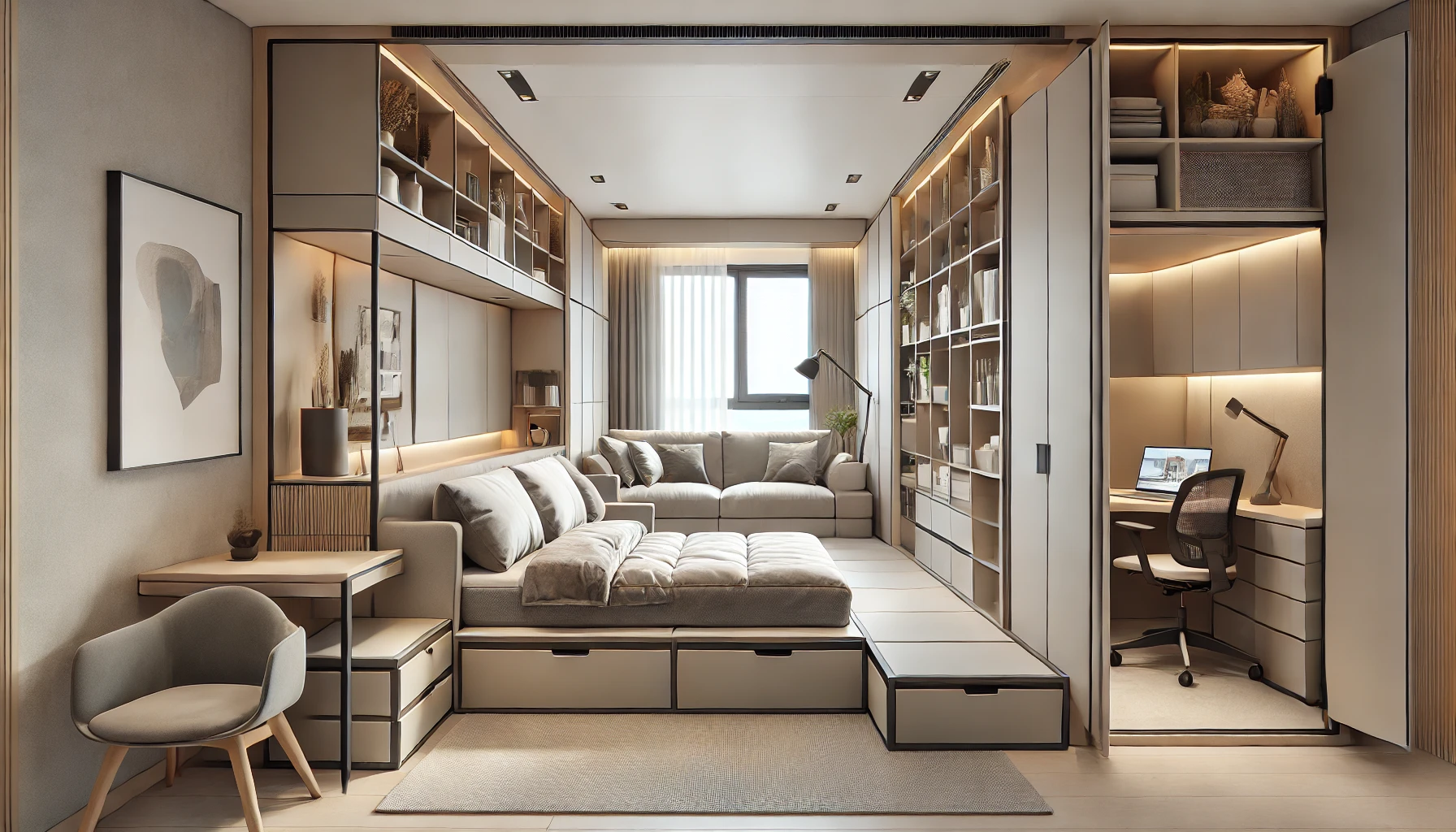
Welcome to the world of multifunctional room design! As a professional home designer, I know the value of making every inch of your home count. Whether you’re living in a compact space or simply want to optimize your home’s layout, multifunctional rooms are the key to combining form and function. In today’s fast-paced world, our living spaces need to work harder, serving multiple purposes without sacrificing style or comfort. From living rooms that double as home offices to guest rooms that transform into exercise spaces, the possibilities are endless.
In this article, we’ll explore how you can create a beautifully designed multifunctional room that meets all your needs. We’ll cover practical furniture choices, layout tips, and design trends to help you maximize space and flexibility. If you’ve ever wanted to transform a single room into a space that works for everything from relaxation to productivity, you’re in the right place. Let’s dive into the best ways to design your multifunctional room and make the most of your space.
Multifunctional Room Design Ideas
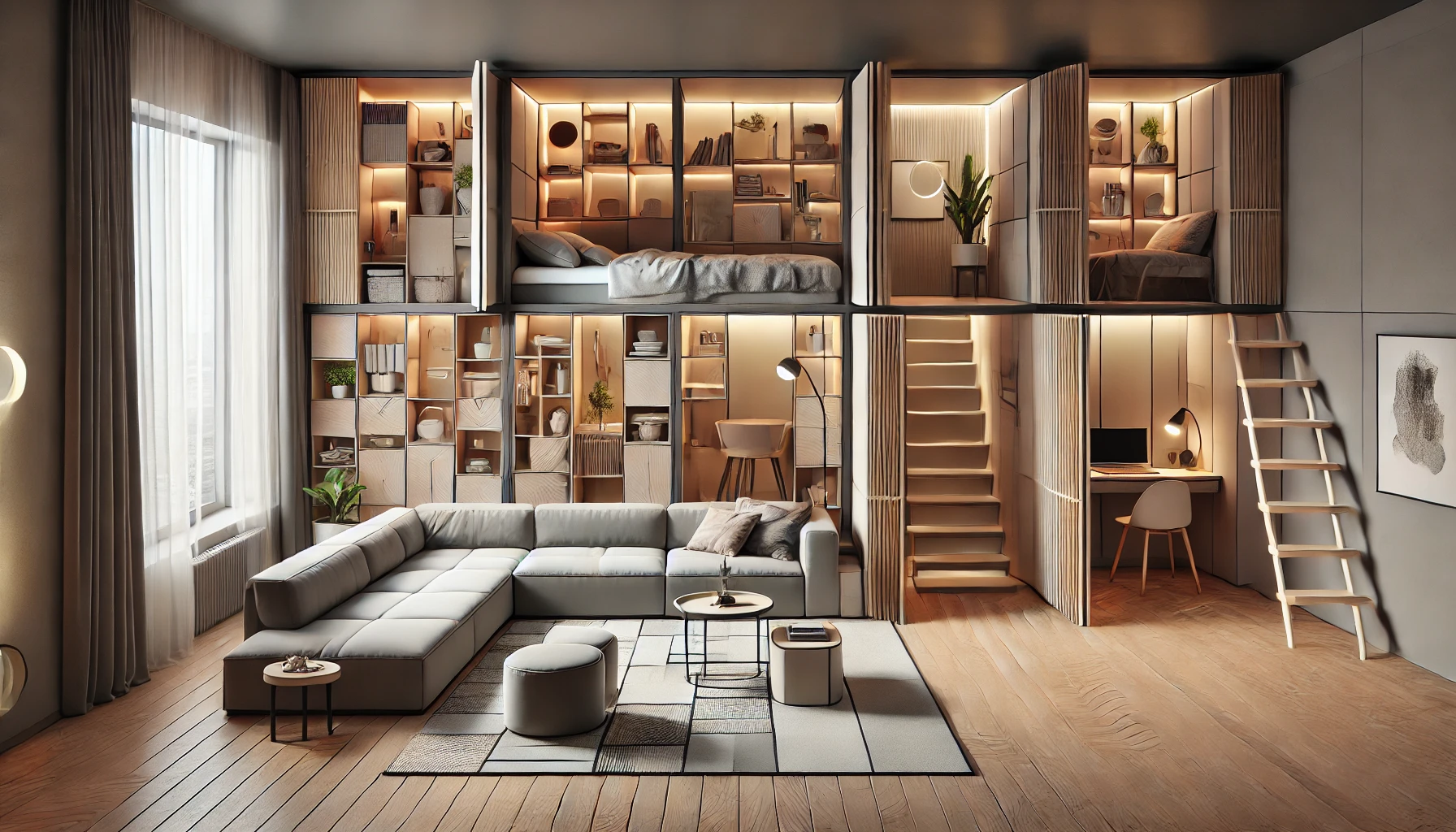
Creating a Flexible Layout
The foundation of any multifunctional room is a flexible layout. This means arranging furniture in a way that allows you to easily switch between uses. Consider placing furniture on wheels or choosing modular pieces that can be reconfigured as needed. By creating zones within the room—such as a lounging area, a work area, or a dining area—you can make the space feel multifunctional without sacrificing comfort or style.
Using area rugs or different lighting schemes can also help define these zones, making it clear which area is for which purpose. A flexible layout ensures that no matter what you need the room for, it can quickly adapt to your needs.
Incorporating Multi-Purpose Furniture
Investing in multifunctional furniture is one of the best ways to create a versatile room. For example, a sofa bed can turn a living room into a guest bedroom, while a fold-out desk can turn a small corner into a home office. Ottomans with hidden storage, wall-mounted desks, and extendable dining tables are just a few examples of furniture that serve more than one purpose.
Choosing multi-purpose furniture not only saves space but also keeps the room tidy and organized. With the right pieces, you can make even the smallest room serve multiple functions with ease.
How to Create a Multifunctional Room
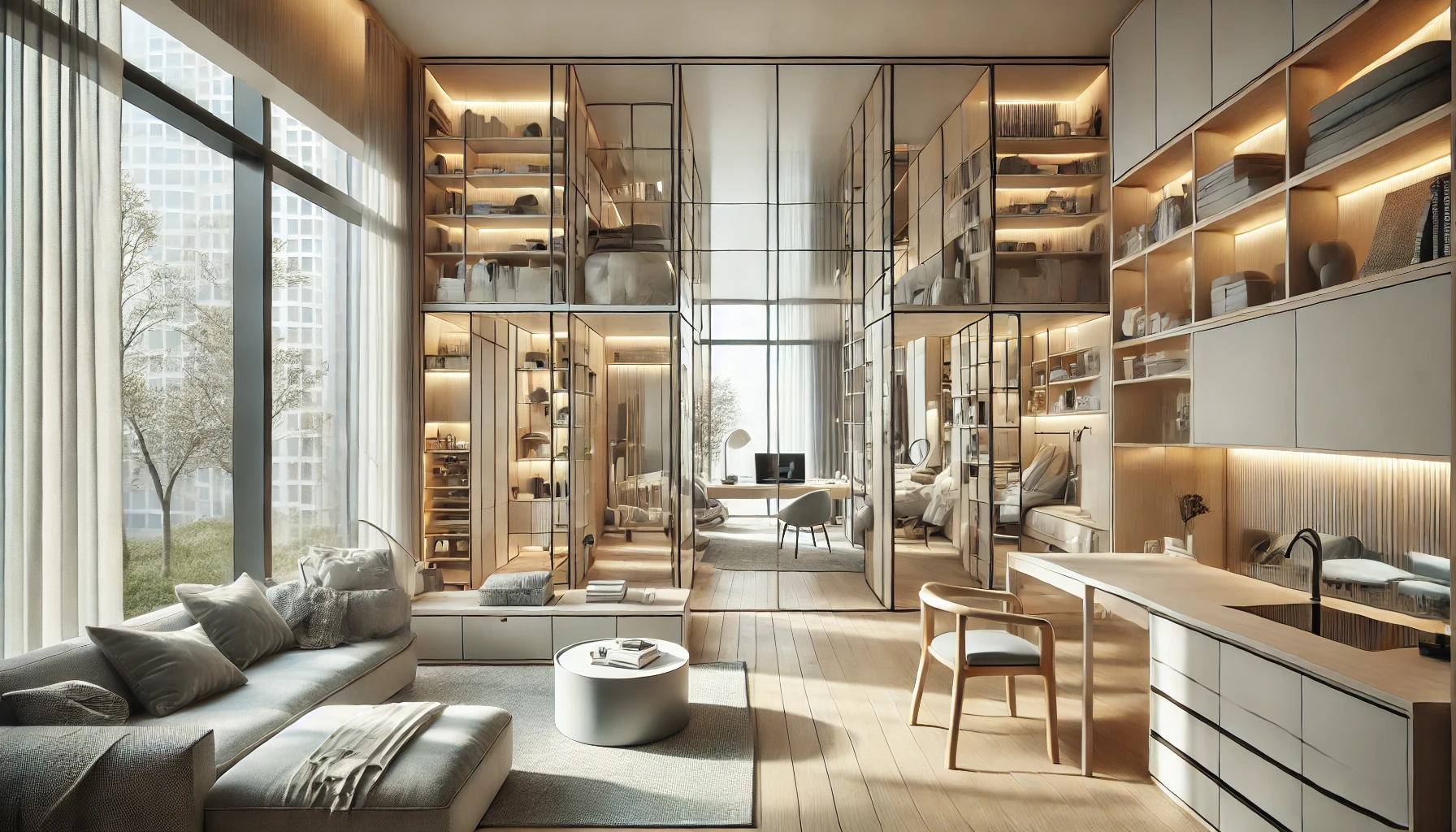
Identifying Your Needs
The first step in creating a multifunctional room is identifying what you need the space to do. Will it be a home office by day and a guest room by night? Or perhaps a living room that also functions as a workout space? Once you know your needs, you can start planning the room’s layout and choosing furniture that fits those purposes.
Write down all the functions the room will serve and prioritize them. This will help you figure out which pieces of furniture and storage solutions are most important for making the room work for you.
Maximizing Natural Light and Space
When creating a multifunctional room, natural light is your best friend. It helps make the space feel larger, brighter, and more welcoming. Arrange furniture to take advantage of any windows or skylights, and use mirrors to reflect light around the room.
If your room is small, think vertically. Use tall shelves and wall-mounted storage to free up floor space and create more room for movement. The key is to make the room feel open and airy, even if it’s serving multiple purposes.
Small Space Multifunctional Room Design
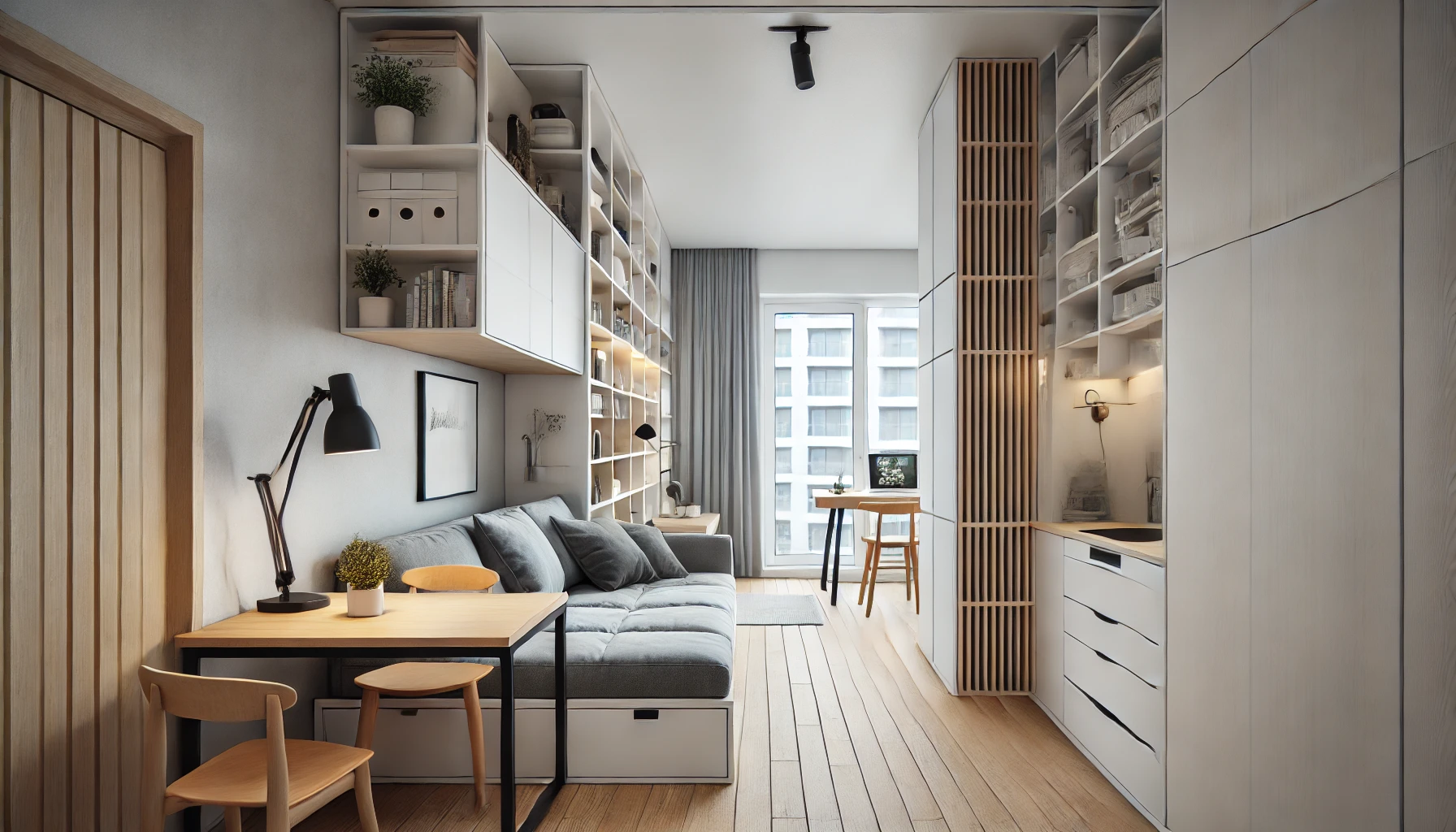
Maximizing Every Inch of a Small Room
Small spaces can be tricky to design, but with multifunctional furniture and a strategic layout, they can still be incredibly functional. Consider using furniture that serves more than one purpose, such as a daybed that can be used for seating and sleeping or a dining table that doubles as a desk. This type of design helps make the most of a limited footprint.
In small spaces, vertical storage is essential. Use wall-mounted shelves, cabinets, or even fold-down desks to keep the floor clear and create more usable space. Every square foot counts in a small multifunctional room, so choose furniture and decor wisely.
Using Sliding Doors and Dividers
Sliding doors or room dividers can help separate different areas of a small multifunctional room. For example, a sliding door can separate a living space from a home office, giving you privacy when needed. Dividers are another great option for breaking up a small room into distinct zones without taking up too much space.
These design elements help maintain privacy and functionality while keeping the room feeling open and spacious. The key is to create visual separation without making the room feel cramped.
Best Furniture for Multifunctional Rooms
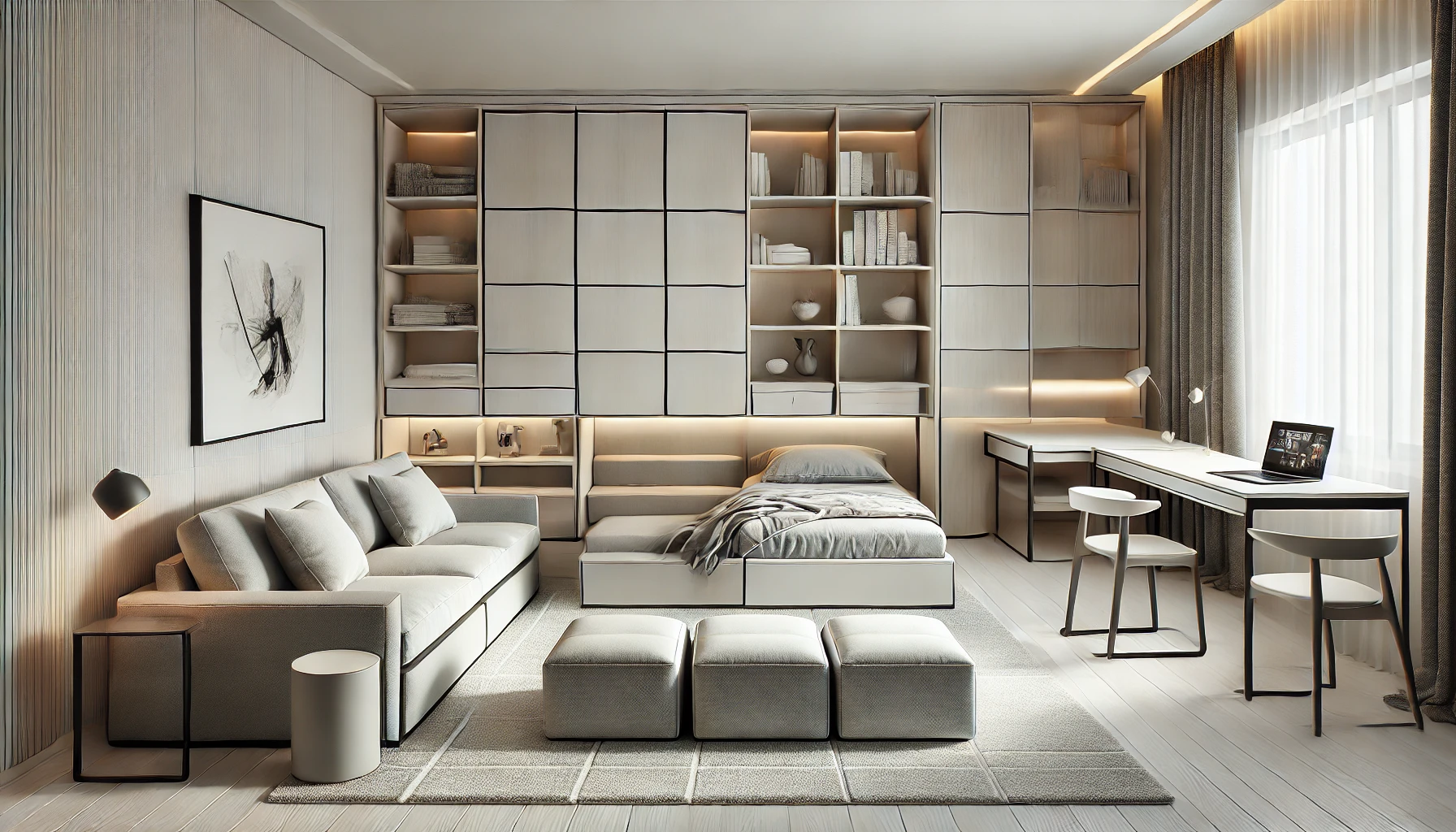
Choosing Versatile Pieces
When designing a multifunctional room, it’s important to choose furniture that can adapt to different uses. For example, a sleeper sofa can function as both seating and a bed, while an extendable dining table can also serve as a workspace. These versatile pieces allow you to quickly and easily switch the room’s function depending on your needs.
Modular furniture, such as sectional sofas or modular shelving, is another great option for multifunctional rooms. These pieces can be rearranged to suit different activities, making them perfect for dynamic spaces.
Incorporating Hidden Storage
Storage is key in multifunctional rooms, especially if you need to keep the space clutter-free while using it for different purposes. Ottomans, benches, and coffee tables with hidden storage compartments are perfect for tucking away items when they’re not in use.
Wall-mounted storage units or floating shelves are also great for keeping the floor clear while providing ample storage for books, office supplies, or other items. The goal is to keep the room looking clean and organized, no matter how many functions it serves.
Multifunctional Living Room Design
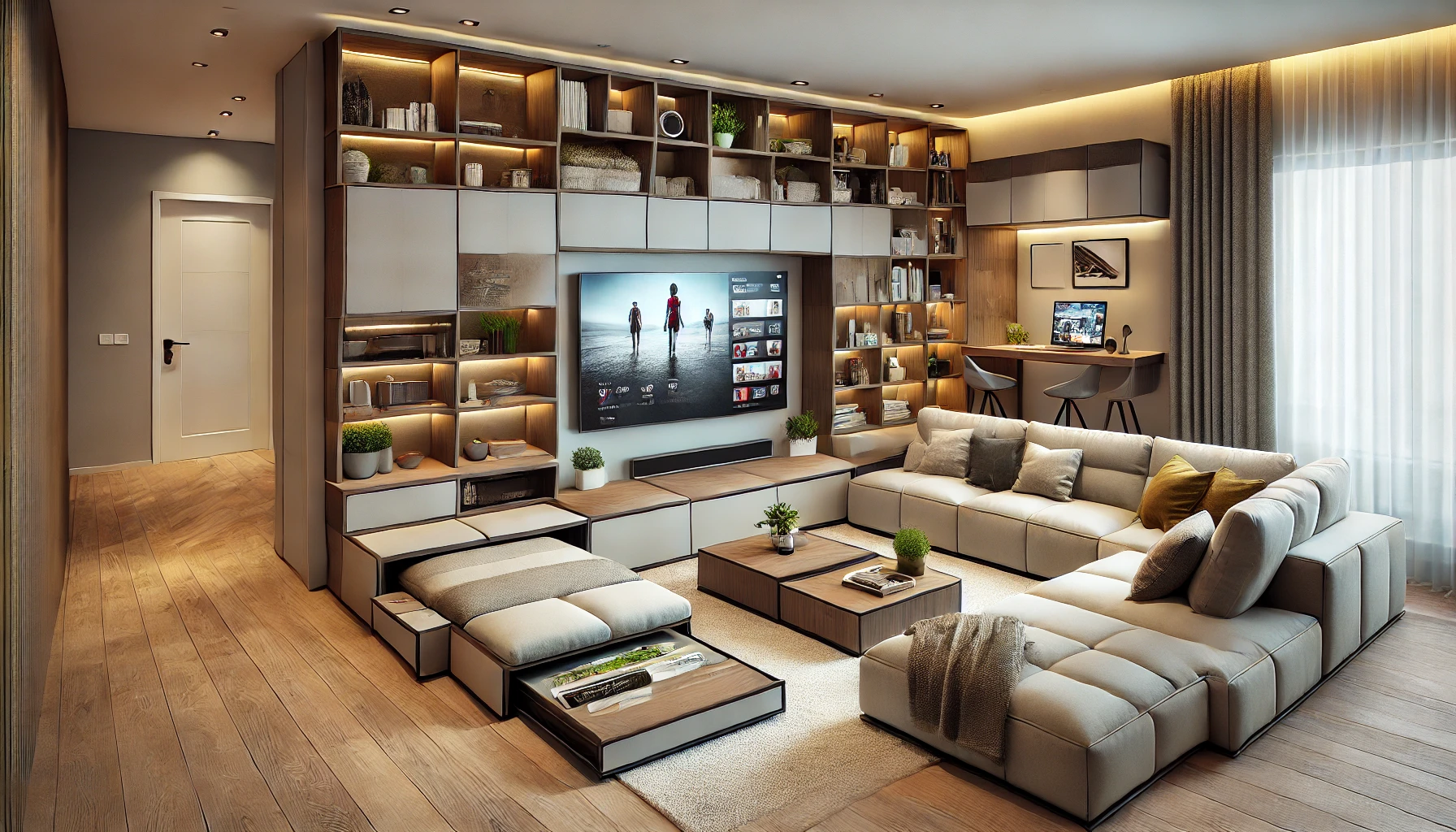
Combining Entertainment and Relaxation
A multifunctional living room should be designed for both entertainment and relaxation. Start by choosing comfortable seating that can easily be rearranged for movie nights or gatherings. A coffee table with storage can serve as a place to keep remote controls, magazines, or even board games, making it both functional and stylish.
For added versatility, consider adding a fold-out desk that can be hidden away when not in use. This allows the living room to double as a home office or study space, without taking away from its primary function as a place to relax.
Creating a Multi-Use Entertainment Area
If your living room also functions as a home theater or gaming area, consider how you can store entertainment equipment when it’s not in use. Floating shelves, TV consoles with storage, or hidden media centers are all great options for keeping electronics out of sight when the room is being used for other activities.
By creating dedicated spaces for both relaxation and entertainment, you can design a multifunctional living room that serves all your needs without feeling cluttered or overwhelming.
Open-Concept Multifunctional Room Ideas
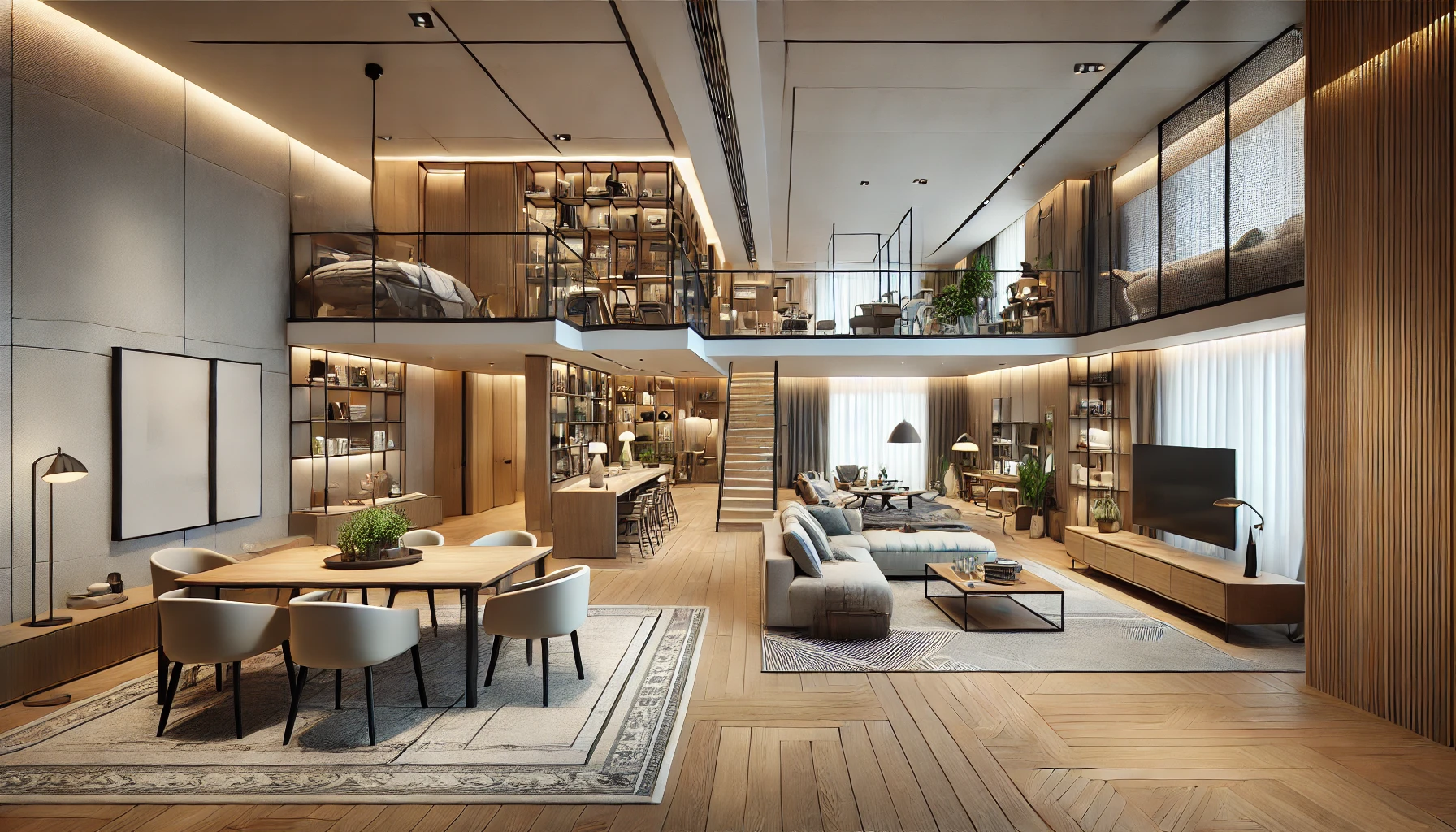
Defining Zones in an Open Space
In an open-concept room, defining different zones is essential for creating a multifunctional space. Use area rugs, furniture arrangements, or lighting to visually separate areas for different purposes, such as dining, lounging, or working. This helps create a sense of structure and organization within a large, open space.
For example, placing a sofa in the center of the room can help separate the living area from the dining area, while a large dining table can serve as both a place to eat and work. These subtle divisions create a multifunctional space without the need for walls.
Using Furniture to Create Flow
In an open-concept multifunctional room, the furniture should create a natural flow between different areas. Choose pieces that work well together and allow for easy movement between spaces. For example, low-profile furniture can help maintain sightlines, making the room feel more open and connected.
Furniture placement is key in open-concept spaces, so experiment with different arrangements to find the one that best suits your needs. The goal is to create a space that feels cohesive and functional, no matter how many purposes it serves.
Home Office and Guest Room Combo Design
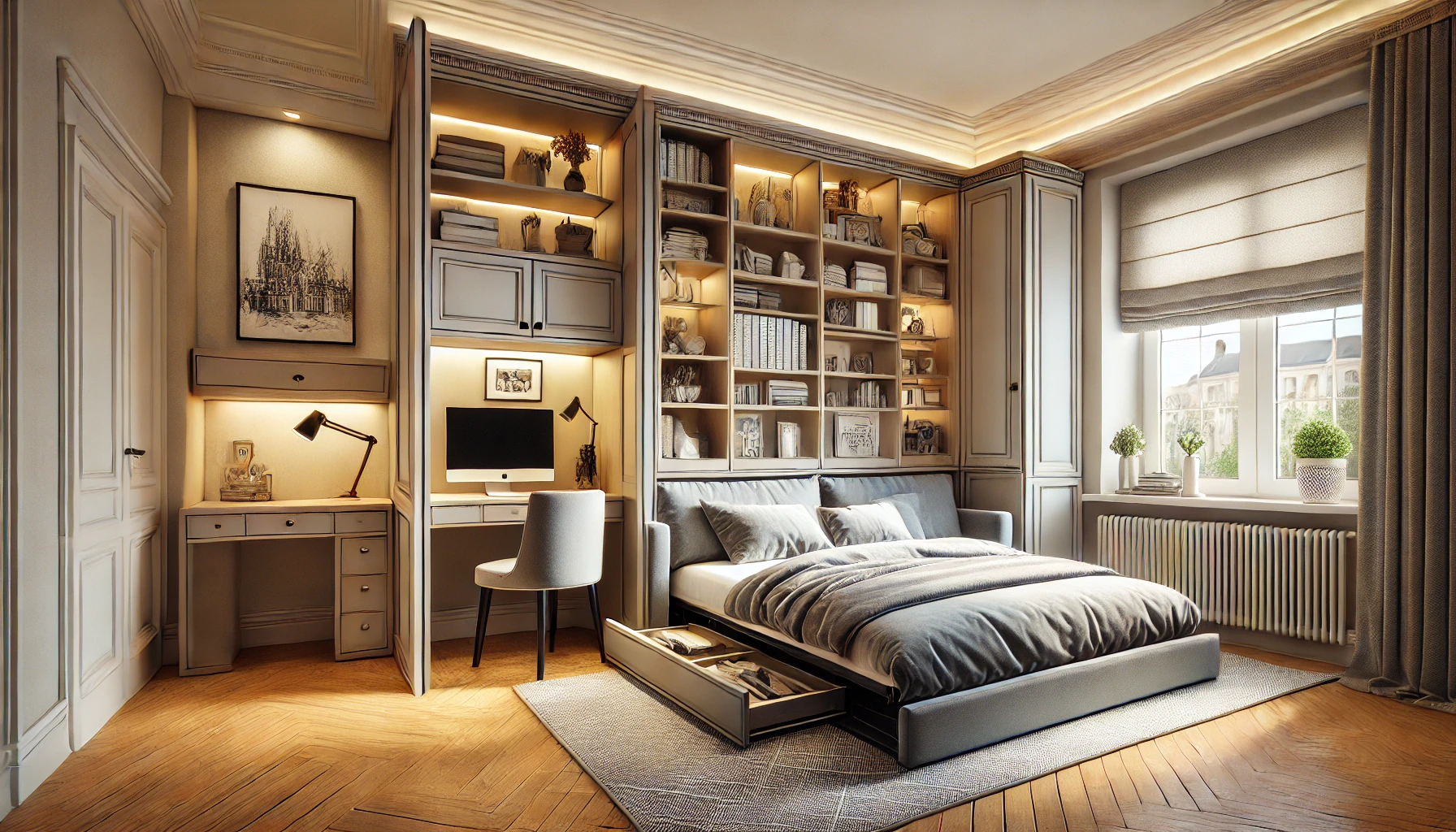
Creating a Dual-Function Space
A home office and guest room combo is a practical solution for those who need both a workspace and a place for guests to stay. Start by choosing a comfortable sleeper sofa or daybed that can easily transform into a guest bed when needed. This allows you to use the room for work during the day and easily convert it into a guest room at night.
To maximize space, consider adding a fold-out desk or wall-mounted workspace that can be tucked away when not in use. This ensures that the room remains functional for both purposes without feeling overcrowded or cluttered.
Adding Storage for Dual Functions
Storage is essential in a home office and guest room combo, as the room will need to accommodate both office supplies and guest belongings. Use built-in shelves, cabinets, or under-bed storage to keep everything organized and out of sight when the room is in use for one function or the other.
This ensures that the room is always ready for guests while still being a productive workspace for you. With the right furniture and storage solutions, a home office and guest room combo can be both stylish and practical.
Multifunctional Room Storage Solutions
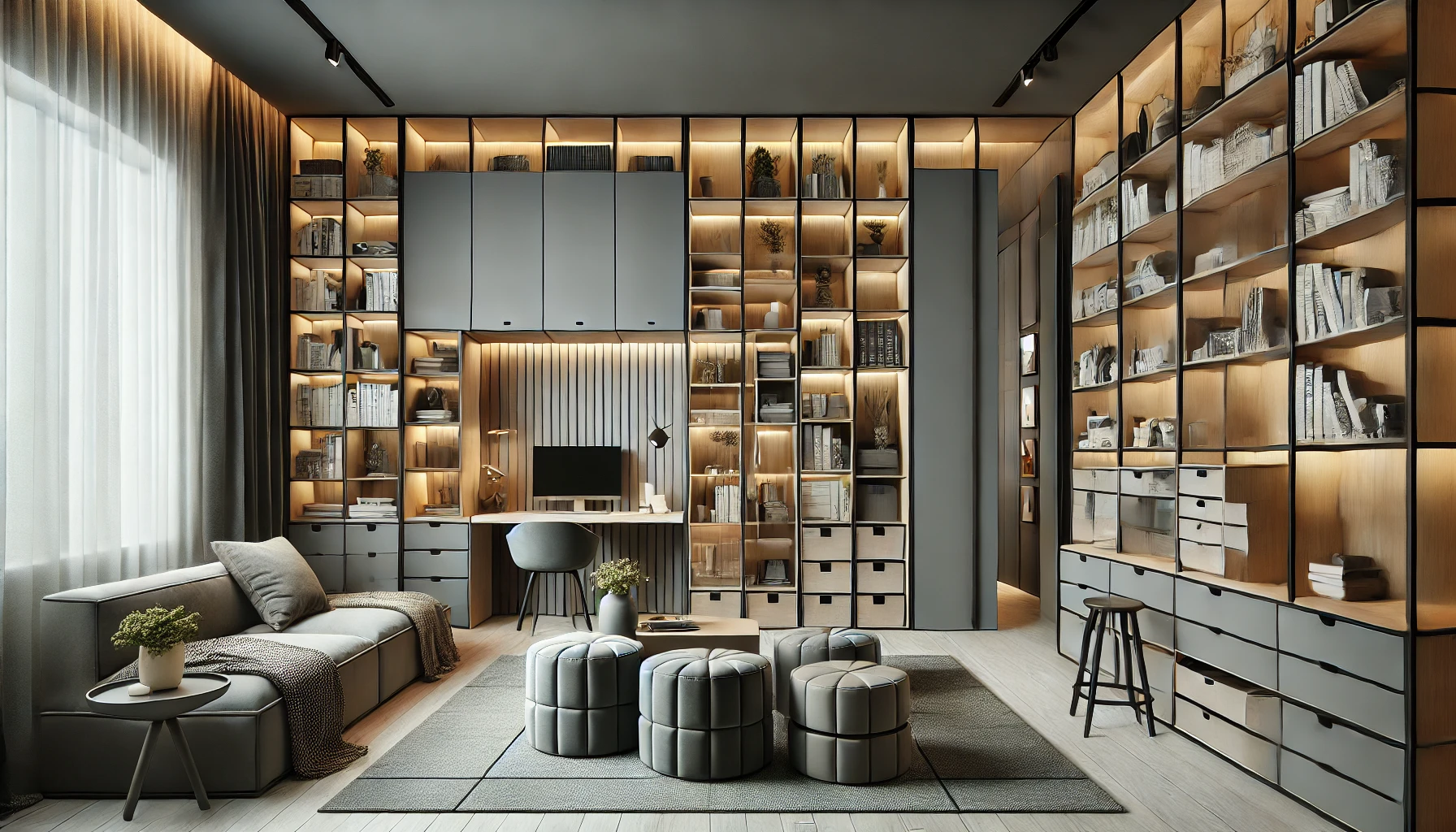
Utilizing Vertical Storage
In a multifunctional room, vertical storage is a game-changer. Tall bookshelves, wall-mounted cabinets, and floating shelves allow you to store items without taking up valuable floor space. This frees up the room for other activities, such as work, relaxation, or entertaining guests.
For added versatility, consider using modular shelving that can be rearranged to fit your needs. This type of storage can grow and change with your room’s functions, making it a practical solution for dynamic spaces.
Incorporating Hidden Storage
Hidden storage is another essential element of multifunctional room design. Ottomans, coffee tables, and benches with built-in storage allow you to keep the room tidy while still providing ample space for all your belongings. These dual-purpose pieces are perfect for rooms that serve multiple functions, as they help keep clutter out of sight.
Wall-mounted storage, such as fold-away desks or cabinets, is another great way to maximize space while keeping the room looking clean and organized. The key is to find storage solutions that enhance the room’s functionality without detracting from its aesthetic.
Multifunctional Bedroom Design Ideas
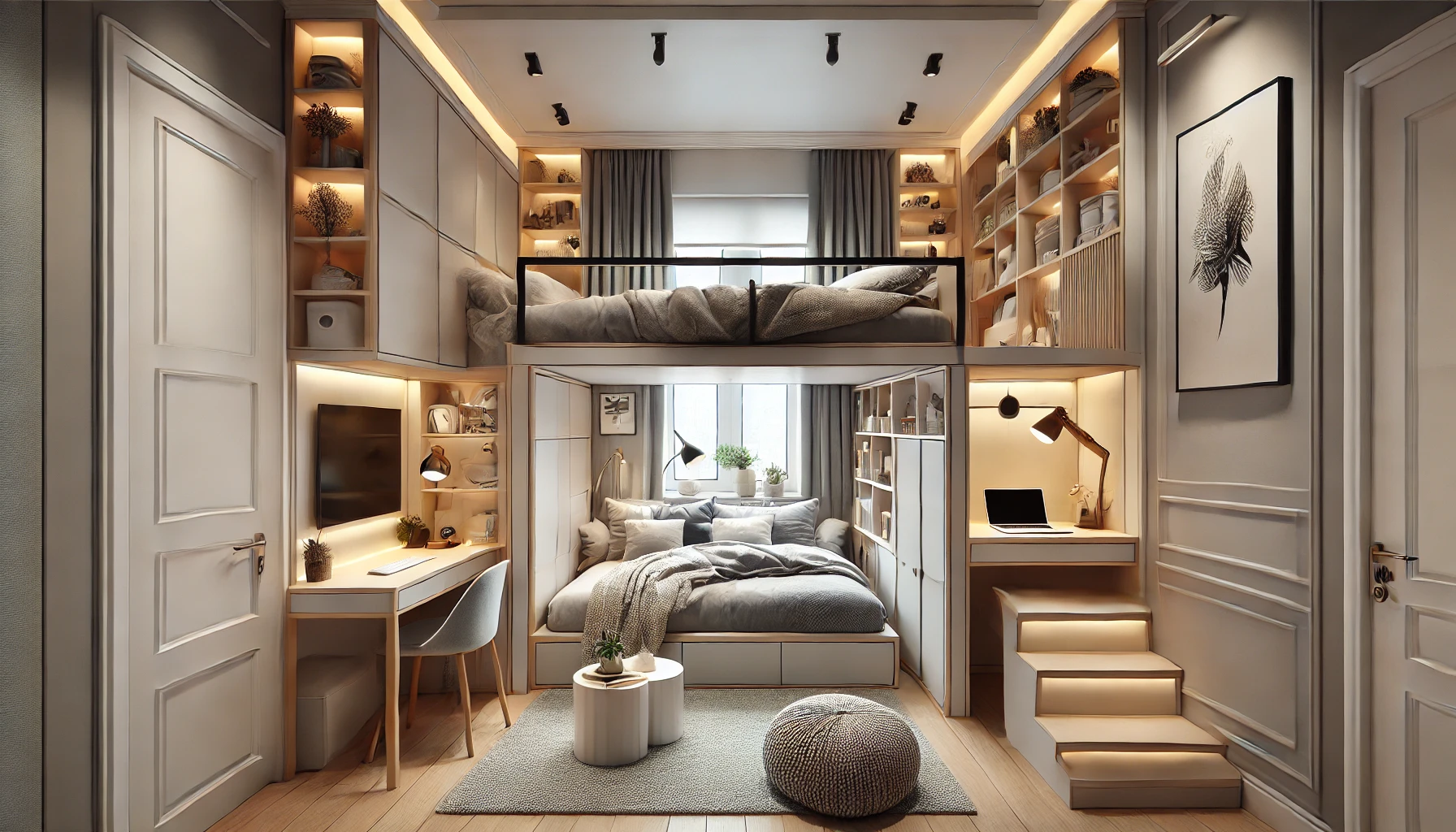
Combining Sleeping and Study Spaces
In a multifunctional bedroom, combining a sleeping area with a study or work area is a practical solution. Start by choosing a bed that offers storage underneath or a loft bed that frees up space for a desk or seating area below. This allows you to create a productive workspace without sacrificing comfort or style.
Incorporating a desk with hidden storage or a fold-out table can also help create a functional study space that doesn’t take up too much room. By carefully planning the layout and furniture choices, you can design a multifunctional bedroom that meets all your needs.
Creating a Relaxing and Functional Environment
To ensure that your multifunctional bedroom is both relaxing and functional, choose calming colors and decor that promote relaxation. Soft lighting, plush bedding, and cozy textures can help create a peaceful atmosphere, even if the room serves multiple purposes.
At the same time, make sure that your study or work area is well-lit and organized, with plenty of storage to keep the room clutter-free. This balance between function and relaxation is key to creating a bedroom that feels both comfortable and versatile.
Transform Your Home with Multifunctional Room Design
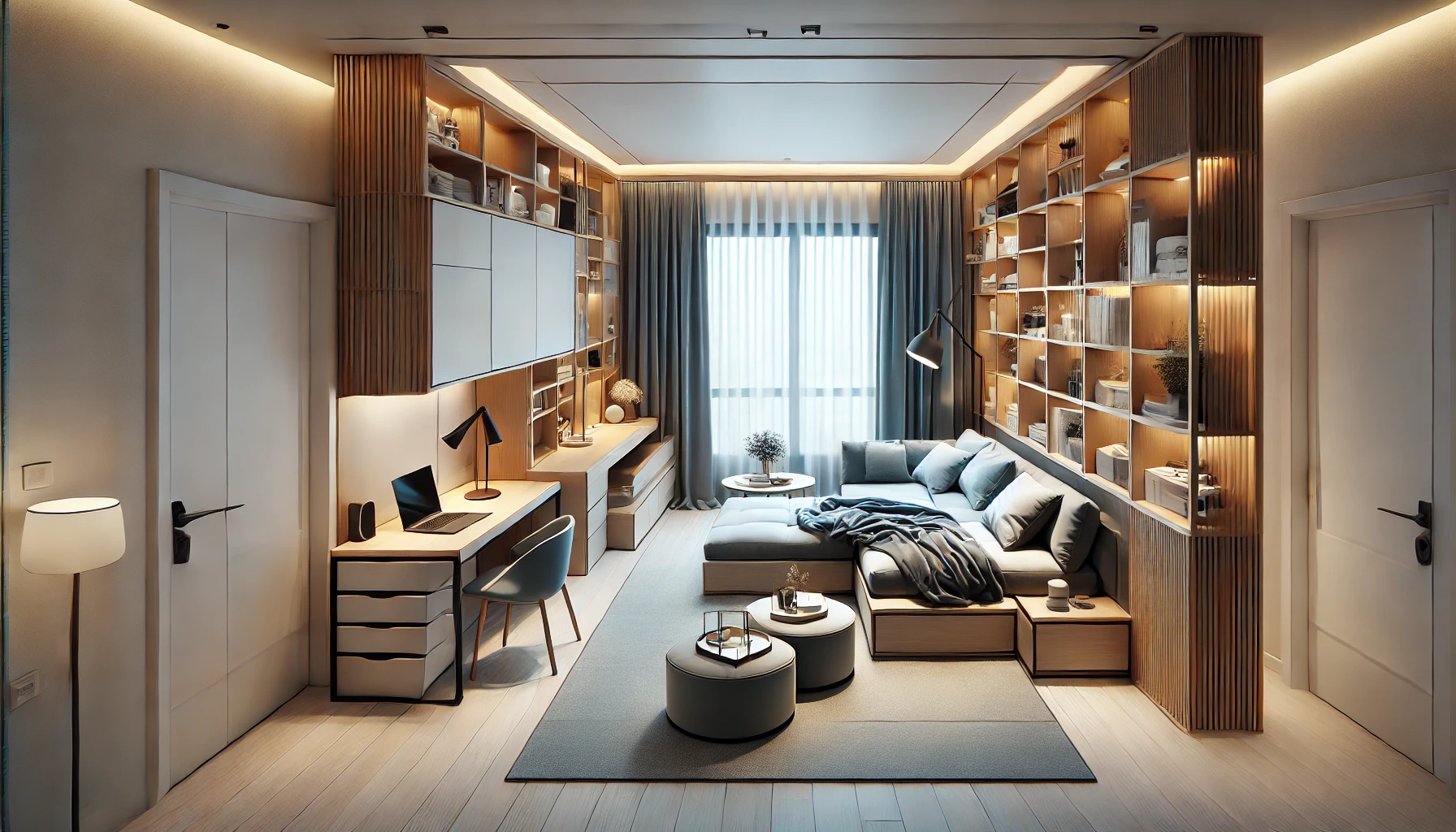
Designing a multifunctional room is a practical and stylish way to make the most of your home’s space. Whether you live in a small apartment or a spacious house, multifunctional rooms allow you to combine different functions in a single, well-designed space. From home offices that double as guest rooms to living rooms that serve as entertainment hubs, the possibilities are endless.
By choosing versatile furniture, maximizing storage, and creating flexible layouts, you can design a room that adapts to your needs and looks great while doing it. If you’re ready to transform your home and create a space that works for you, now is the time to explore the world of multifunctional room design.
Ready to Create Your Dream Multifunctional Room?
Thank you for reading! If you’re ready to create a multifunctional room that meets all your needs, we’re here to help. As professional home designers, we can guide you through the process of choosing the right furniture, layouts, and design elements to maximize your space. Whether you’re redesigning a small apartment or adding functionality to a larger home, we can help you create a space that is both beautiful and practical.
Contact us today to schedule a consultation and start your journey toward a home that works for you. Let us help you design the multifunctional room of your dreams, where every inch of space is used to its fullest potential. We look forward to working with you and transforming your home into a space that truly reflects your lifestyle.
F.A.Q: Multifunctional room design
What is a multifunctional room?
A multifunctional room is a space that serves more than one purpose. It can combine areas for work, relaxation, entertainment, or guest accommodation in a single room by using versatile furniture and smart design techniques.
How do I design a multifunctional room?
To design a multifunctional room, identify the different uses the space will serve. Choose flexible furniture, like a sofa bed or fold-out desk, and create defined zones with area rugs or lighting. Modular storage and furniture help maximize space while keeping the room functional and organized.
What furniture is best for multifunctional rooms?
The best furniture for multifunctional rooms includes modular pieces, sofa beds, fold-out desks, and storage ottomans. Look for versatile items that can easily adapt to different uses, such as expandable tables and furniture with hidden storage.
Can small spaces be multifunctional?
Yes, even small spaces can be multifunctional with the right design. Use vertical storage, fold-away furniture, and multifunctional pieces like a daybed or wall-mounted desk to make the most of limited space. Creating distinct zones helps to keep the space functional and organized.
How can I divide a multifunctional room?
You can divide a multifunctional room by using sliding doors, room dividers, curtains, or furniture arrangements. These options create distinct zones for different activities, such as separating a living area from a workspace, without needing permanent walls.
What are the benefits of multifunctional room design?
Multifunctional room design maximizes the utility of a space, especially in smaller homes. It allows one room to serve multiple purposes, making the most of available space while maintaining an organized, aesthetically pleasing environment. This type of design also promotes flexibility and adaptability.
How do I make a multifunctional room look stylish?
To make a multifunctional room look stylish, choose cohesive colors, modern furniture, and smart storage solutions. Keep the design clean and uncluttered by using hidden storage and minimalistic decor. Adding statement pieces, such as bold artwork or elegant lighting, can enhance the aesthetic while maintaining functionality.
How can I create a multifunctional home office?
To create a multifunctional home office, use a compact desk or a wall-mounted fold-out desk that can be hidden away when not in use. Consider adding a sofa bed to allow the room to double as a guest room. Use storage solutions that keep work materials organized and out of sight when the space is being used for other purposes.
What are the best storage solutions for multifunctional rooms?
The best storage solutions for multifunctional rooms include modular shelving, floating shelves, furniture with hidden storage, and built-in cabinets. These options keep the space clutter-free and adaptable, allowing the room to easily transition between functions.
Can a living room be multifunctional?
Yes, a living room can be multifunctional. It can serve as a relaxation area, home office, entertainment space, and even a guest room with the right furniture choices. Incorporating a sofa bed, fold-out desk, and media storage makes the living room highly versatile without sacrificing comfort or style.
How do I maximize space in a multifunctional room?
Maximize space in a multifunctional room by using space-saving furniture like wall-mounted desks, fold-out tables, and modular sofas. Vertical storage, such as tall bookshelves or cabinets, also helps keep the floor clear and provides additional storage. Keep the layout flexible and organized to ensure smooth transitions between functions.
What design styles work best for multifunctional rooms?
Modern and minimalist design styles work best for multifunctional rooms. These styles emphasize clean lines, functional furniture, and uncluttered spaces. Scandinavian design, which focuses on simplicity and utility, is also a great choice for multifunctional spaces.
Can a bedroom be a multifunctional space?
Yes, a bedroom can be a multifunctional space by combining sleeping, working, and storage functions. Use a loft bed or a bed with built-in storage to free up floor space, and add a compact desk or vanity for a work or study area. Keep the design cohesive and clutter-free for a calm and functional environment.
How do I create a kids’ playroom that is multifunctional?
To create a multifunctional kids’ playroom, include areas for play, study, and storage. Use furniture that doubles as storage, such as toy boxes that can also serve as seating. A fold-out desk or table provides a space for homework or creative activities, and open shelving helps keep toys and books organized and accessible.
What are multifunctional design trends?
Multifunctional design trends include modular furniture, flexible layouts, space-saving solutions, and smart storage. Open-concept living spaces with defined zones, as well as modern minimalism, are popular approaches to creating multifunctional rooms that are both practical and stylish.
 Home Designing Get expert home decor tips and design inspiration at HomeDesigning.blog. Transform your living spaces with trending styles and DIY ideas!
Home Designing Get expert home decor tips and design inspiration at HomeDesigning.blog. Transform your living spaces with trending styles and DIY ideas!
